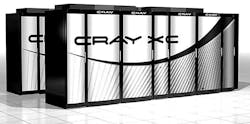Military to upgrade high-performance computing (HPC) to do complex calculations at supercomputing speeds
HUNTSVILLE, Ala. – U.S. military researchers needed upgrades to the DOD Supercomputing Resource Center (DSRC) at Stennis Space Center, Miss. They found their solution from Cray Inc. in Seattle.
Officials of the U.S. Army Corps of Engineers support center in Huntsville, Ala., announced a $26.5 million five-year contract to Cray on Monday for the U.S. Department of Defense (DOD) High Performance Computing Modernization program.
The high-performance computing (HPC) facility at Stennis Space Center is one of five DSRCs that support U.S. military computationally based science and engineering that help scientists analyze an ever-increasing volume and complexity of data by developing visualization and analysis tools. High-performance computing typically is synonymous with supercomputing.
The DOD's High Performance Computing Modernization program was begun in 1993 to modernize the military's supercomputer infrastructure to explore new theories; use validated applications in design and testing to reduce the time and cost of developing weapon systems; and carry out complex calculations in real-time to produce just-in-time information for decision makers on the battlefield.
Related: ARINC supercomputers help design and model the performance of complex aviation antennas
The program seeks to develop and field the most advanced supercomputers and storage systems available for routine use by military researchers at the program's five supercomputing centers across the nation. In addition to Stennis Space Center, supercomputing centers are at Wright-Patterson Air Force Base, Ohio; the Army Research Laboratory at Aberdeen Proving Ground, Md.; the Army Engineer Research and Development Center at Vicksburg, Miss.; and the Maui High Performance Computing Center at Kihei, Hawaii.
Among the most important projects of the High Performance Computing Modernization program is the Defense Research and Engineering Network (DREN) -- a component of the Global Information Grid (GIG) that provides high-bandwidth, low-latency computer networking that serves as a proving ground for new networking and cyber security technologies.
Five years ago Cray won a $30.75 million order to provide high-performance computing resources at Stennis Space Center. Cray specializes in supercomputers, open-systems data storage, and analytics for real-time data discovery.
Related: Pentagon pours another $53.1 million into the five military supercomputer research centers
The Cray XC50 supercomputer has a peak system performance of 500 quadrillion floating point operations per second (petaFLOPs), and 1 petaFLOP in one cabinet. It supports Cavium ThunderX2 processors, NVIDIA Tesla P100 PCI Express graphics processing units (GPUs) and Intel Xeon Scalable processors. This supercomputer works with the Aries network and Cray HPC-optimized software stack that includes the Cray Linux Environment and Cray Programing Environment.
Cray also offers the Shasta supercomputer, introduced in late 2018 for massive converged modeling, simulation, artificial intelligence (AI), and analytics. Built to be data-centric, it runs fast and diverse workloads all at the same time, and supports multiple processor and accelerator architectures and system interconnect technologies like the Cray Slingshot.
For more information contact Cray online at www.cray.com, the DOD High-Performance Computing Modernization program office at www.hpc.mil, or the Army Engineering and Support Center-Huntsville at www.hnc.usace.army.mil.

John Keller | Editor-in-Chief
John Keller is the Editor-in-Chief, Military & Aerospace Electronics Magazine--provides extensive coverage and analysis of enabling electronics and optoelectronic technologies in military, space and commercial aviation applications. John has been a member of the Military & Aerospace Electronics staff since 1989 and chief editor since 1995.

